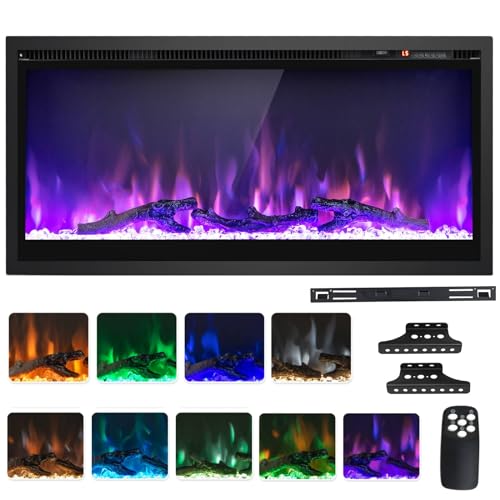The Modern Elegance of Wall Hung Fireplaces
In the realm of modern interior decoration, the wall hung fireplace has actually become a striking blend of functionality and aesthetics. These setups supply warmth and atmosphere while serving as a smooth centerpiece in different settings, including homes, workplaces, and dining establishments. With various styles and technologies readily available, wall hung fireplaces cater to varied tastes and requirements. This short article looks into their advantages, different types, setup factors to consider, and maintenance suggestions, along with a comprehensive FAQ section to address common questions.
The Appeal of Wall Hung Fireplaces
The growing appeal of wall hung fireplaces can be credited to numerous factors:
- Space-Saving Design: Ideal for smaller sized areas, wall hung systems release up flooring space, optimizing room layouts.
- Smooth Aesthetics: Known for their modern-day appearance, these fireplaces enhance the overall design of a room, using a contemporary touch.
- Versatility: They can be set up in numerous areas, including living spaces, bed rooms, and outdoor areas.
- Ease of Installation: Many designs are created for simpler setup compared to standard fireplaces.
- Fuel Options: Available in electric, gas, and bioethanol versions, consumers have the versatility to select based upon choice and usefulness.
Table: Comparison of Different Types of Wall Hung Fireplaces
| Type | Fuel Source | Installation Complexity | Maintenance Needs | Performance | Aesthetic appeals |
|---|---|---|---|---|---|
| Electric | Electric | Low | Very little | High | Sleek, modern style |
| Gas | Natural gas or lp | Moderate | Regular servicing needed | High | Conventional to modern-day |
| Bioethanol | Bioethanol fuel | Low | Minimal | Moderate | Stylish and varied |
Types of Wall Hung Fireplaces
1. Electric Wall Hung Fireplaces
Electric designs are the easiest to install and normally require only a standard electrical outlet. www.fireplacesandstoves.uk make use of LED technology to create practical flames, while their heating capabilities can efficiently warm a space. Lots of electric fireplaces come with adjustable flame settings and remote controls, enabling for customized ambiance.
2. Gas Wall Hung Fireplaces
Gas systems provide a genuine fire experience with real flames. They can be vented or ventless, with vented designs requiring installation of a chimney or flue. Gas fireplaces need a greater level of installation expertise, and regular servicing is vital for safe operation.
3. Bioethanol Wall Hung Fireplaces
These environment-friendly fireplaces use bioethanol, a renewable resource source. They do not require a chimney, making them flexible for positioning within a space. Nevertheless, the flames produced can be unpredictable in size, and mindful adherence to producer standards is essential for security.
Installation Considerations
When pondering a wall hung fireplace, it's crucial to think about the list below elements:
- Location: Choose a location that enables enough clearance from flammable products. Fireplaces need to ideally be installed on an accent wall to maximize visual impact.
- Structural Support: Ensure the wall can support the weight of the fireplace, particularly for heavier gas models.
- Ventilation Needs: Gas fireplaces require appropriate ventilation to avoid the accumulation of harmful gases. Speak with a professional regarding the suitable venting system.
- Electrical Access: For electric fireplaces, distance to an electrical outlet is important. Hiding wires for a tidy installation boosts aesthetics.
Upkeep Tips
Correct upkeep is important to lengthen the life and security of wall hung fireplaces. Secret upkeep tips consist of:
Regular Cleaning:
- Dust and debris can build up. Clean down the unit with a soft, moist fabric.
- Usage specialized cleansers for glass surfaces to maintain clarity.
Yearly Inspection:
- For gas fireplaces, have an expert inspect vents and connections annually for security.
- Check for gas leakages and ensure appropriate operation of the ignition system.
Fuel Management:
- Ensure the proper type and quality of fuel is used, specifically for bioethanol designs.
- Keep extra stocks of fuel on hand but keep them in a safe location, far from the fireplace.
Pilot Light Monitoring:
- For gas fireplaces, frequently examine that the pilot burner is lit and operating.
Frequently asked questions
Q1: Are wall hung fireplaces safe to use?
A1: Yes, when set up and used according to maker guidelines, wall hung fireplaces are safe. Regular upkeep and evaluations contribute to safe operation.
Q2: Can wall hung fireplaces be used in apartments?
A2: Absolutely. Lots of electric and bioethanol designs are particularly fit for apartments, as they do not need extensive venting.
Q3: How much do wall hung fireplaces cost?
A3: Prices can differ significantly based upon the type, brand name, and functions. Electric fireplaces might begin around ₤ 300, while gas models can range from ₤ 1,000 to over ₤ 5,000, depending upon setup complexity.
Q4: Do wall hung fireplaces produce as much heat as traditional fireplaces?
A4: While they might not normally produce the exact same amount of heat as traditional wood-burning fireplaces, electric and gas models can efficiently heat a space of typical size when used properly.
Q5: Can I install a wall hung fireplace on any kind of wall?
A5: Most installations need a solid, structural assistance wall. Constantly talk to a professional to figure out if your wall type appropriates for installation.
Wall hung fireplaces represent a modern alternative to standard heating approaches, integrating effectiveness with contemporary design. They use numerous benefits, including space-saving installations and visual enhancement, making them a favorable option for today's property owners and designers. With appropriate installation and upkeep, these sophisticated fixtures can provide heat and beauty for several years to come.

